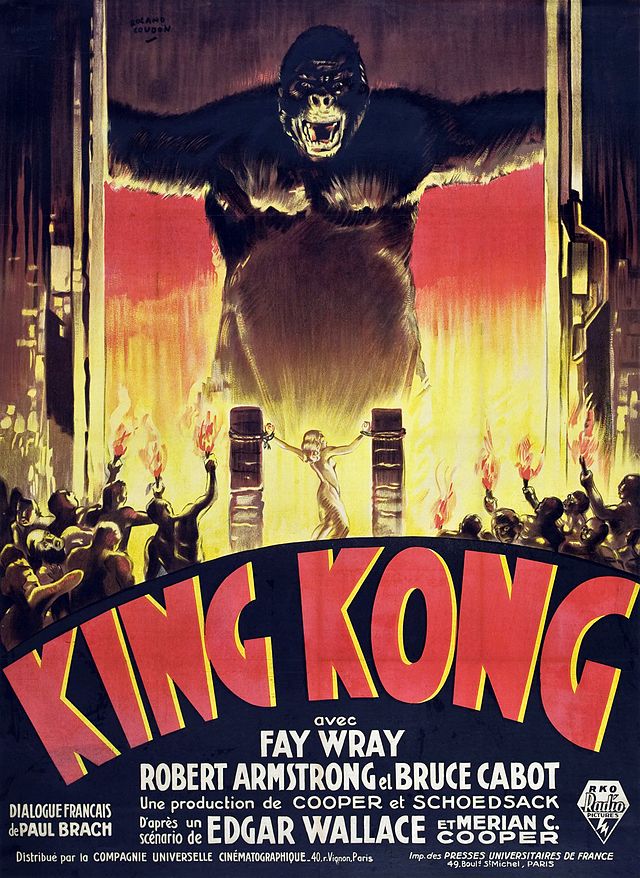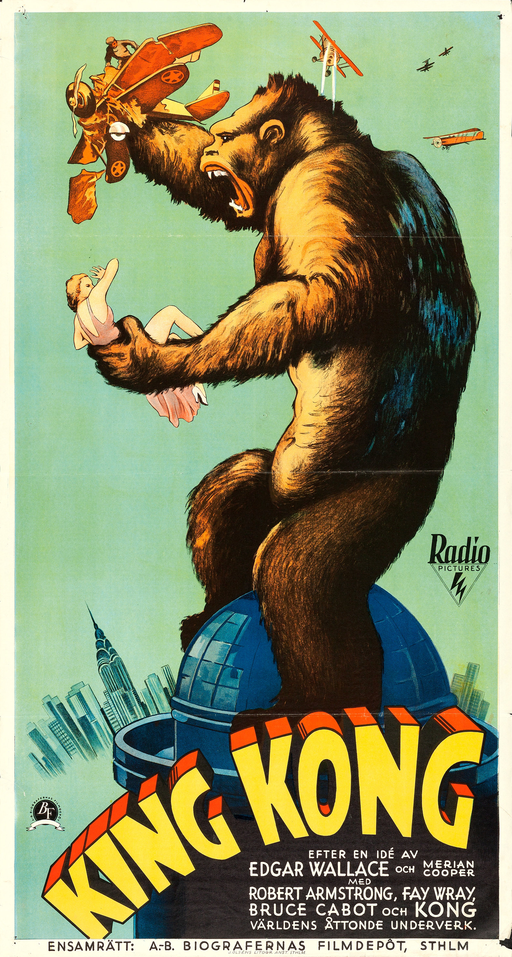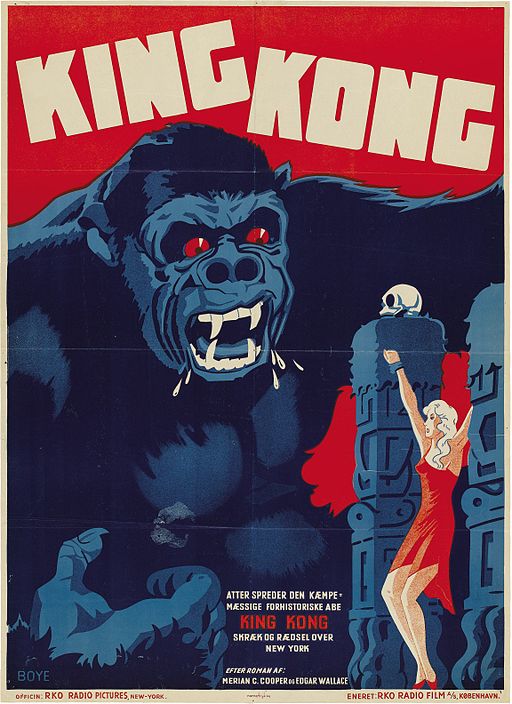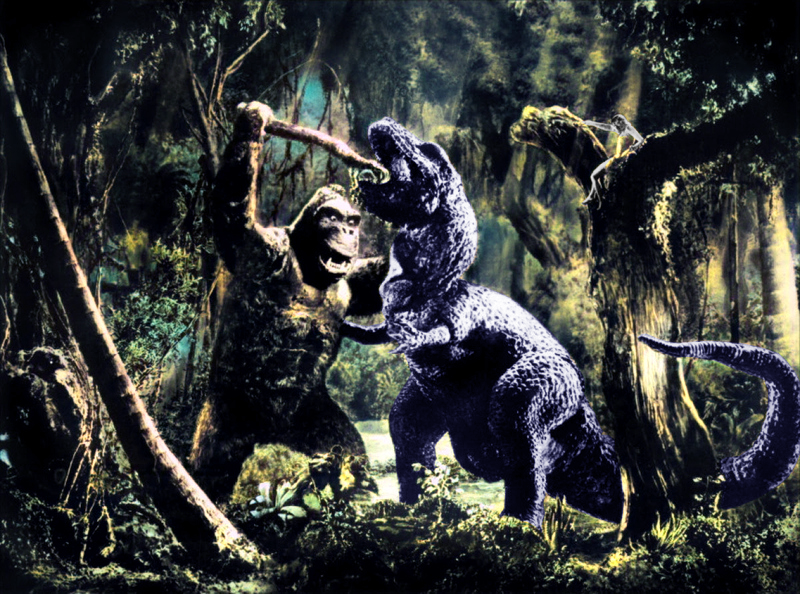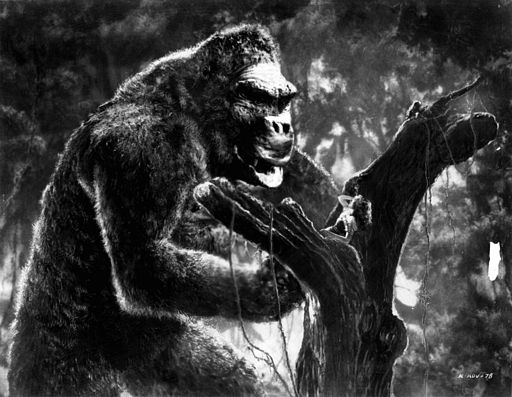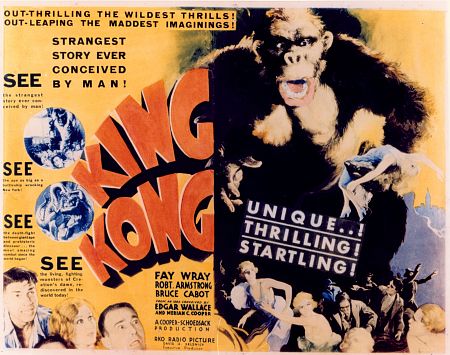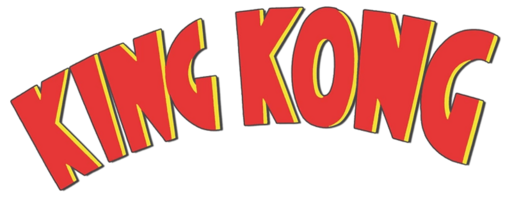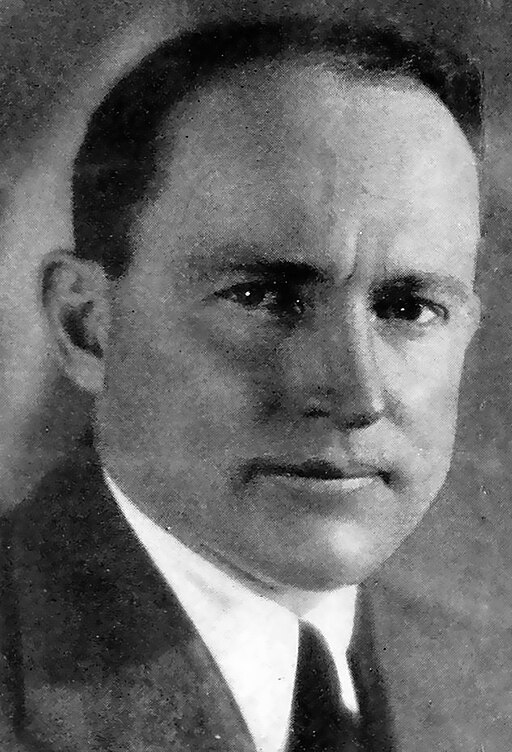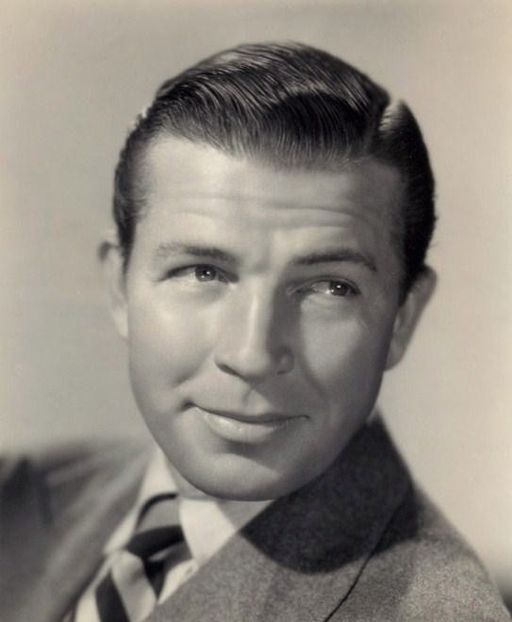King Kong - 1933
back| Released by | RKO Radio Pictures |
| Director | Merian C. Cooper and Ernest B. Schoedsack |
| Producer | Merian C. Cooper and Ernest B. Schoedsack |
| Script | James Ashmore Creelman and Ruth Rose |
| Cinematography | Edward Linden, J.O. Taylor, Vernon Walker |
| Music by | Max Steiner |
| Running time | 100 minutes |
| Film budget | Estimated around $672,000 |
| Box office sales | Approximately $5.3 million (initial release) |
| Main cast | Fay Wray - Robert Armstrong - Bruce Cabot |
King Kong
A truly groundbreaking cinematic spectacle
"King Kong" (1933), directed by Merian C. Cooper and Ernest B. Schoedsack, is a groundbreaking film that tells the story of an ambitious filmmaker who captures a gigantic ape, Kong, on the mysterious Skull Island and brings him to New York City.
Starring Fay Wray, Robert Armstrong, and Bruce Cabot, the film is renowned for its innovative use of stop-motion animation, which brought the titular character to life with unprecedented realism. Its blend of adventure, horror, and romance, coupled with pioneering special effects, set new standards in filmmaking.
The portrayal of Kong, both terrifying and sympathetic, added depth and emotion, influencing the depiction of creatures in cinema. "King Kong" significantly impacted the genres of horror and adventure, inspiring countless remakes and adaptations.
Related
King Kong – 1933
Summary and Analysis
"King Kong" (1933) is a landmark American monster adventure film that has left an indelible mark on cinema history.
Summary
Setting and Introduction: The film begins in New York City during the Great Depression. Film director Carl Denham, known for shooting wildlife films in remote and exotic locations, is preparing for a new project. He hires a down-on-her-luck actress, Ann Darrow, to be the leading lady.
Voyage to Skull Island: The crew sets sail for the mysterious Skull Island, located in the Indian Ocean. En route, Ann forms a romantic connection with the ship's first mate, Jack Driscoll. Upon arriving at Skull Island, they encounter a native tribe who are about to sacrifice a young woman to a creature they call "Kong".
Capture of Ann and Encounter with Kong: The tribal chief becomes infatuated with Ann's beauty and decides to offer her to Kong instead. That night, Ann is kidnapped by the natives and offered to Kong, a giant gorilla. Kong is smitten with Ann and takes her deep into the island.
Rescue Mission and Island Adventures: Denham, Jack, and the crew mount a rescue mission. The island reveals prehistoric creatures, and the team faces various perils. Kong fights off several monsters to protect Ann, showcasing his might and the beginnings of a bond between him and Ann.
Capture and Transport to New York: Kong is eventually subdued by Denham, who decides to bring him back to New York as a showpiece. Kong, displayed as the "Eighth Wonder of the World", breaks free from his chains, creating havoc in search of Ann.
Climax on the Empire State Building: Kong finds Ann and takes her to the top of the Empire State Building. There, he faces a final stand against airplanes. Despite his might, Kong is mortally wounded by the gunfire and falls to his death.
Tragic Ending: The film ends with Denham's famous line, "It wasn't the airplanes. It was Beauty killed the Beast," highlighting the tragic nature of Kong's downfall and the consequences of human ambition and interference with nature.
Analysis
Technological Innovation: "King Kong" was revolutionary in its use of special effects, particularly stop-motion animation by Willis O'Brien. The film's technical achievements set a new standard for Hollywood and inspired generations of filmmakers and special effects artists.
Themes and Symbolism: The film explores themes of adventure, the unknown, and the clash between civilization and nature. Kong symbolizes the untamed natural world, ultimately doomed in the face of human encroachment and exploitation.
Cultural Impact: "King Kong" had a significant cultural impact, influencing popular culture, spawning numerous remakes and sequels, and establishing the giant monster (kaiju) genre.
Critique: While groundbreaking, the film also reflects the racial and cultural stereotypes of its time, particularly in its portrayal of the indigenous people of Skull Island.
In conclusion, "King Kong" (1933) is not only a thrilling adventure story but also a poignant tale that highlights the consequences of human hubris and the exploitation of nature. Its groundbreaking effects, coupled with a compelling narrative, have ensured its status as a classic in the annals of cinema history.
Official King Kong Trailer 1933:
Full Cast of the Movie “King Kong”:
- Fay Wray as Ann Darrow
- Robert Armstrong as Carl Denham
- Bruce Cabot as Jack Driscoll
- Frank Reicher as Captain Englehorn
- Sam Hardy as Charles Weston
- Noble Johnson as the Native Chief
- Steve Clemente as the Witch King
- James Flavin as the First Mate
- King Kong (via stop-motion animation) as himself
Analysis of the Direction of Merian C. Cooper:
The direction of Merian C. Cooper for "King Kong" (1933) is a crucial aspect to analyze, as it played a fundamental role in shaping this groundbreaking film. Cooper's vision, creativity, and innovative approach to filmmaking contributed significantly to the movie's enduring legacy. Here's an analysis of his direction:
Visionary Storytelling
- Bold Narrative: Cooper, along with co-director Ernest B. Schoedsack, chose a story that was ambitious for its time. The narrative of "King Kong" combined adventure, romance, horror, and fantasy, set against the backdrop of an exotic, unexplored world. This bold blend of genres was a testament to Cooper's imaginative storytelling.
- Allegorical Elements: Cooper infused the film with layers of allegory, particularly in the portrayal of Kong as both a terrifying beast and a sympathetic character. This duality added depth to the film and reflected Cooper's nuanced approach to storytelling.
Pioneering Techniques
- Innovative Special Effects: Cooper's use of stop-motion animation, miniatures, and rear projection was pioneering. The animation of Kong, in particular, was a monumental achievement. Cooper's dedication to pushing the boundaries of what was technically possible in filmmaking is evident in these groundbreaking effects.
- Integration of Effects and Acting: Cooper directed scenes where actors interacted with stop-motion creatures, a challenging task at the time. His ability to blend live-action performances with animated elements was innovative and contributed to the film's realism and emotional impact.
Thematic Depth
- Man vs. Nature: Under Cooper's direction, "King Kong" explored themes of man's intrusion into nature and the consequences of exploiting and misunderstanding the natural world. The tragic fate of Kong serves as a poignant commentary on these themes.
- The Beauty and the Beast Motif: Cooper's direction effectively highlighted the classic tale of beauty and the beast, with Fay Wray's Ann Darrow and Kong representing this timeless dynamic. This aspect added a layer of tragic romance to the film.
Cultural Sensitivity
- Representation of Indigenous People: While innovative in many ways, the film also reflects the cultural and racial attitudes of its time, particularly in its portrayal of the indigenous inhabitants of Skull Island. Modern viewers often critique this aspect of the film, which is a point to consider in the context of Cooper's direction.
Impact on Cinema
- Influencing Future Filmmakers: Cooper's direction in "King Kong" had a lasting impact on the film industry. His techniques inspired future generations of filmmakers and special effects artists, laying the groundwork for the modern blockbuster.
Analysis of the Performance of Fay Wray:
Characterization of Ann Darrow
- Damsel in Distress: Ann Darrow is often cited as one of the quintessential "damsel in distress" characters in early cinema. She is the central female protagonist who is kidnapped by Kong and needs to be rescued. This archetype was common in films of the era.
- Symbol of Beauty and Innocence: Ann represents beauty, innocence, and vulnerability. Her character is central to the film's exploration of the "Beauty and the Beast" theme. She is the catalyst for Kong's more gentle and protective behavior, highlighting a different aspect of his character beyond just being a monstrous beast.
- Connection with Kong: Ann's interactions with Kong are pivotal. Though initially terrified, her reactions to Kong evolve subtly, suggesting a complex relationship that goes beyond simple fear. This dynamic adds depth to the narrative.
Fay Wray's Performance
- Emotional Range: Wray's performance is notable for its emotional range. She convincingly portrays fear, shock, and faint vulnerability, which were essential to the role. Her ability to act convincingly in scenes with an unseen, animated character was groundbreaking for the time.
- Iconic Scream Queen: Fay Wray became known as one of the original "scream queens" because of her role in this film. Her screams in "King Kong" are iconic and were a significant part of her performance, adding to the tension and drama of the film.
- Physical Acting: Given the limitations of special effects at the time, much of Wray's interaction with Kong required imaginative and physical acting, as she often had to act against props or inanimate objects that represented Kong.
Cultural and Cinematic Impact
- Defining Role: The role of Ann Darrow became a defining one for Fay Wray's career. It solidified her place in Hollywood history and influenced the portrayal of female characters in subsequent monster and adventure films.
- Influence on the Genre: Wray's portrayal influenced the development of the horror and adventure genre, particularly in how female leads were depicted in relation to monstrous or fantastical creatures.
Where was “King Kong” filmed?
The 1933 film "King Kong" was primarily filmed in California. The majority of the production took place in the Hollywood studios of RKO Radio Pictures. Here are some key locations:
- RKO Studios: The intricate sets representing Skull Island and the New York scenes, including the finale with the Empire State Building, were constructed and filmed at the RKO Studios in Hollywood, Los Angeles.
- Culver City: Some parts of the film were shot in Culver City, California, where larger studio spaces were available for the more expansive set pieces.
- San Pedro, California: The scenes involving the ship, the S.S. Venture, were filmed in the harbor of San Pedro, which is part of the Los Angeles Port area.
Memorable Quotes from the Film King Kong:
"Oh, no, it wasn't the airplanes. It was Beauty killed the Beast."
- Spoken by: Carl Denham
- Context: This is the film's closing line, reflecting on the tragic fall of Kong. It encapsulates the central theme of the film, the destructive nature of beauty and innocence on primal force and wildness.
"It's money and adventure and fame. It's the thrill of a lifetime and a long sea voyage that starts at six o'clock tomorrow morning."
- Spoken by: Carl Denham
- Context: Denham says this to Ann Darrow when he is trying to convince her to join the voyage that will lead them to Skull Island. It highlights his character's adventurous spirit and foreshadows the extraordinary events to come.
"We're millionaires, boys, I'll share it with all of you. Why, in a few months, it'll be up in lights on Broadway: 'Kong, the Eighth Wonder of the World.'"
- Spoken by: Carl Denham
- Context: Denham says this after capturing Kong, revealing his ambition and the commercial potential he sees in Kong.
"Don't be alarmed, ladies and gentlemen. Those chains are made of chrome steel."
- Spoken by: Carl Denham
- Context: Denham reassures the audience during Kong's exhibition in New York, ironically underestimating Kong's strength and the impending chaos.
"Ann, I don't suppose... I mean, well you don't feel anything about me, do you?"
- Spoken by: Jack Driscoll
- Context: Jack awkwardly expresses his feelings to Ann, highlighting the developing romantic subplot in the film.
"Look at the size of that hand!"
- Spoken by: A crew member
- Context: Said when the crew first encounters evidence of Kong's enormous size, setting the stage for the awe and fear inspired by Kong.
The impact of Cinematography on the success of “King Kong”:
The cinematography of "King Kong" (1933) played a pivotal role in its success and enduring legacy. Directed by Merian C. Cooper and Ernest B. Schoedsack, with cinematography by Edward Linden, J.O. Taylor, and Vernon Walker, the film is a benchmark in cinematic history for several reasons:
Innovative Techniques
- Stop-Motion Animation: The film is best known for its groundbreaking use of stop-motion animation, spearheaded by Willis O'Brien. This technique brought Kong and the various creatures of Skull Island to life, allowing for a level of dynamism and realism that was unprecedented at the time.
- Miniature and Full-Scale Sets: The seamless integration of miniature sets with full-scale ones allowed for convincing depictions of Kong's immense size. This mix created an immersive world that was believable and captivating for audiences.
- Rear Projection and Matte Paintings: The film employed advanced rear projection techniques and matte paintings to create the illusion of depth and vast landscapes. These techniques enabled the filmmakers to place live actors in fantastical settings convincingly.
Artistic Expression
- Lighting and Shadow Play: The use of light and shadow in "King Kong" added to the film's dramatic and ominous atmosphere. The chiaroscuro effect, particularly in scenes set on Skull Island, created a sense of mystery and foreboding.
- Camera Angles and Movement: Strategic camera angles and movements were used to emphasize Kong's size and the scale of the environment. Low-angle shots of Kong, for instance, made him appear even more towering and formidable.
Emotional Impact
- Close-Ups for Emotional Resonance: Close-ups of characters, especially Fay Wray's Ann Darrow, captured the emotional intensity of the film. The terror, wonder, and empathy displayed on the characters' faces were crucial in engaging the audience.
- Action Sequences: The film's action sequences, particularly Kong's battles with other creatures and his rampage through New York, were choreographed and shot in a way that maximized their impact and maintained a fast-paced and gripping narrative.
Influence on Future Filmmaking
- Setting a New Standard: "King Kong" set a new standard for special effects in film. Its innovative use of various cinematographic techniques inspired future generations of filmmakers and special effects artists.
- Blueprint for Adventure Films: The film established a blueprint for how adventure films, especially those involving creatures and fantastical elements, could be shot to create suspense, excitement, and emotional depth.
Awards and Nominations:
"King Kong" (1933) is recognized as a cinematic masterpiece and a landmark in the history of film, particularly for its groundbreaking special effects and storytelling. However, it's important to note that during the time of its release, the landscape of film awards was quite different from today.
Academy Awards:
In 1933, the Oscars did not have categories that would recognize the type of technical and artistic achievements that "King Kong" represented, such as special effects. Therefore, it did not receive any Oscar nominations or awards.
Later Recognition:
- The film has since been recognized for its historical, cultural, and aesthetic significance.
- It was added to the National Film Registry by the Library of Congress, which honors films that are "culturally, historically, or aesthetically significant."
- "King Kong" has often been ranked highly on lists of the greatest films of all time by various film critics and organizations.
Contextual Note
- Recognition in Its Era: In the 1930s, the film industry and its award systems were not as expansive in recognizing a wide range of cinematic achievements as they are today. Many films that are now considered classics were not recognized with awards during their initial release.
- Legacy: The impact and legacy of "King Kong" go beyond awards. Its influence on the genres of horror, adventure, and fantasy, and its pioneering role in special effects, have cemented its status as a classic in film history.

